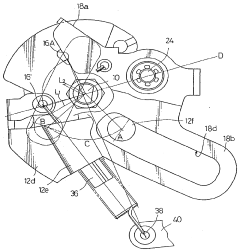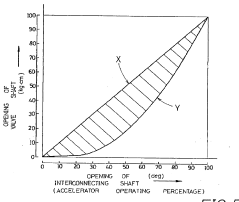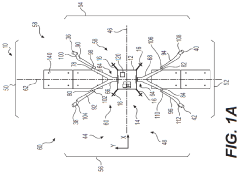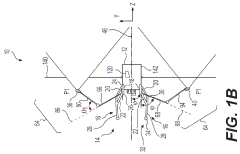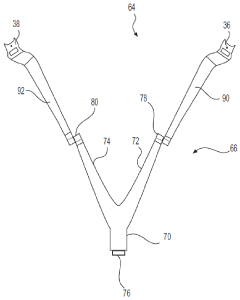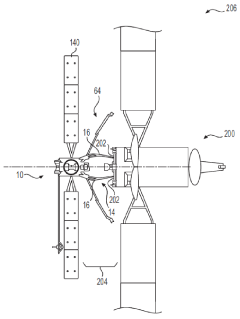Throttle Body Applications in Satellite Systems
JUL 18, 20259 MIN READ
Generate Your Research Report Instantly with AI Agent
Patsnap Eureka helps you evaluate technical feasibility & market potential.
Satellite Propulsion Evolution and Objectives
Satellite propulsion systems have undergone significant evolution since the dawn of the space age. Initially, satellites relied on simple cold gas thrusters for attitude control and minor orbital adjustments. As space missions became more complex, the need for more efficient and capable propulsion systems grew, leading to the development of various technologies.
The 1960s and 1970s saw the introduction of hydrazine monopropellant thrusters, which offered improved specific impulse and thrust compared to cold gas systems. This advancement allowed for more precise station-keeping and longer operational lifetimes for satellites. The subsequent decades witnessed the emergence of bipropellant systems, utilizing hypergolic fuels like nitrogen tetroxide and hydrazine, further enhancing performance and enabling more ambitious missions.
In recent years, electric propulsion technologies have gained prominence in satellite systems. Ion thrusters and Hall effect thrusters, which use electrical energy to accelerate propellant particles, offer significantly higher specific impulse than chemical propulsion systems. This efficiency translates to reduced propellant mass, allowing satellites to carry larger payloads or operate for extended periods.
The ongoing evolution of satellite propulsion systems aims to address several key objectives. Firstly, there is a constant drive to improve propulsion efficiency, reducing the amount of propellant required for a given mission. This not only extends satellite lifetimes but also enables more complex orbital maneuvers and mission profiles.
Secondly, the industry is focusing on developing propulsion systems that are more compact and lightweight. As satellite platforms become smaller and more versatile, propulsion systems must adapt to fit within tighter space and mass constraints without sacrificing performance.
Another critical objective is the development of "green" propulsion technologies. Traditional hydrazine-based systems pose environmental and handling risks, prompting research into safer alternatives such as high-performance green propellants (HPGPs) and water-based propulsion systems.
The integration of throttle body applications in satellite propulsion systems represents a significant step in this evolutionary process. Throttle bodies, traditionally used in automotive engines to control air intake, are being adapted for precise flow control in satellite thrusters. This innovation allows for more accurate thrust modulation, enabling finer control over satellite positioning and maneuvers.
Looking ahead, the satellite propulsion industry is exploring advanced concepts such as solar sails, nuclear propulsion, and laser propulsion. These technologies hold the potential to revolutionize space exploration and satellite operations, offering unprecedented capabilities for long-duration missions and interplanetary travel.
The 1960s and 1970s saw the introduction of hydrazine monopropellant thrusters, which offered improved specific impulse and thrust compared to cold gas systems. This advancement allowed for more precise station-keeping and longer operational lifetimes for satellites. The subsequent decades witnessed the emergence of bipropellant systems, utilizing hypergolic fuels like nitrogen tetroxide and hydrazine, further enhancing performance and enabling more ambitious missions.
In recent years, electric propulsion technologies have gained prominence in satellite systems. Ion thrusters and Hall effect thrusters, which use electrical energy to accelerate propellant particles, offer significantly higher specific impulse than chemical propulsion systems. This efficiency translates to reduced propellant mass, allowing satellites to carry larger payloads or operate for extended periods.
The ongoing evolution of satellite propulsion systems aims to address several key objectives. Firstly, there is a constant drive to improve propulsion efficiency, reducing the amount of propellant required for a given mission. This not only extends satellite lifetimes but also enables more complex orbital maneuvers and mission profiles.
Secondly, the industry is focusing on developing propulsion systems that are more compact and lightweight. As satellite platforms become smaller and more versatile, propulsion systems must adapt to fit within tighter space and mass constraints without sacrificing performance.
Another critical objective is the development of "green" propulsion technologies. Traditional hydrazine-based systems pose environmental and handling risks, prompting research into safer alternatives such as high-performance green propellants (HPGPs) and water-based propulsion systems.
The integration of throttle body applications in satellite propulsion systems represents a significant step in this evolutionary process. Throttle bodies, traditionally used in automotive engines to control air intake, are being adapted for precise flow control in satellite thrusters. This innovation allows for more accurate thrust modulation, enabling finer control over satellite positioning and maneuvers.
Looking ahead, the satellite propulsion industry is exploring advanced concepts such as solar sails, nuclear propulsion, and laser propulsion. These technologies hold the potential to revolutionize space exploration and satellite operations, offering unprecedented capabilities for long-duration missions and interplanetary travel.
Market Analysis for Satellite Throttle Body Systems
The market for satellite throttle body systems has been experiencing significant growth in recent years, driven by the increasing demand for more efficient and precise control of satellite propulsion systems. This market segment is closely tied to the broader satellite industry, which has seen a surge in both commercial and government applications.
The global satellite market is projected to reach substantial value in the coming years, with a considerable portion attributed to propulsion systems and components like throttle bodies. The demand for these systems is particularly strong in communication satellites, Earth observation satellites, and small satellite constellations.
A key driver of market growth is the rising number of satellite launches. With the advent of reusable launch vehicles and the miniaturization of satellite technology, the cost of putting satellites into orbit has decreased, leading to an increase in satellite deployments. This trend has created a ripple effect, boosting demand for various satellite components, including throttle body systems.
The market for satellite throttle bodies is also benefiting from the growing interest in electric propulsion systems. As more satellite manufacturers shift towards electric propulsion for station-keeping and orbital maneuvering, the need for precise flow control mechanisms like throttle bodies has increased.
Geographically, North America currently dominates the market, owing to the presence of major satellite manufacturers and space agencies. However, Asia-Pacific is expected to witness the fastest growth, driven by increasing investments in space programs by countries like China, India, and Japan.
The competitive landscape of the satellite throttle body market is characterized by a mix of established aerospace companies and specialized propulsion system manufacturers. These players are continuously investing in research and development to improve the efficiency, reliability, and longevity of throttle body systems.
Customer segments for satellite throttle bodies include government space agencies, commercial satellite operators, and academic institutions involved in space research. Each of these segments has unique requirements, influencing the design and specifications of throttle body systems.
Looking ahead, the market for satellite throttle bodies is expected to continue its growth trajectory. Factors such as the increasing adoption of small satellites for various applications, the development of mega-constellations for global internet coverage, and the growing interest in deep space exploration are likely to sustain demand for advanced propulsion control systems, including throttle bodies.
The global satellite market is projected to reach substantial value in the coming years, with a considerable portion attributed to propulsion systems and components like throttle bodies. The demand for these systems is particularly strong in communication satellites, Earth observation satellites, and small satellite constellations.
A key driver of market growth is the rising number of satellite launches. With the advent of reusable launch vehicles and the miniaturization of satellite technology, the cost of putting satellites into orbit has decreased, leading to an increase in satellite deployments. This trend has created a ripple effect, boosting demand for various satellite components, including throttle body systems.
The market for satellite throttle bodies is also benefiting from the growing interest in electric propulsion systems. As more satellite manufacturers shift towards electric propulsion for station-keeping and orbital maneuvering, the need for precise flow control mechanisms like throttle bodies has increased.
Geographically, North America currently dominates the market, owing to the presence of major satellite manufacturers and space agencies. However, Asia-Pacific is expected to witness the fastest growth, driven by increasing investments in space programs by countries like China, India, and Japan.
The competitive landscape of the satellite throttle body market is characterized by a mix of established aerospace companies and specialized propulsion system manufacturers. These players are continuously investing in research and development to improve the efficiency, reliability, and longevity of throttle body systems.
Customer segments for satellite throttle bodies include government space agencies, commercial satellite operators, and academic institutions involved in space research. Each of these segments has unique requirements, influencing the design and specifications of throttle body systems.
Looking ahead, the market for satellite throttle bodies is expected to continue its growth trajectory. Factors such as the increasing adoption of small satellites for various applications, the development of mega-constellations for global internet coverage, and the growing interest in deep space exploration are likely to sustain demand for advanced propulsion control systems, including throttle bodies.
Current Challenges in Satellite Throttle Body Technology
The application of throttle bodies in satellite systems presents several significant challenges that researchers and engineers are currently grappling with. One of the primary issues is the need for precise and reliable control of propellant flow in microgravity environments. Traditional throttle body designs, which rely on gravity-dependent mechanisms, often fail to perform optimally in space conditions.
Another major challenge lies in the miniaturization of throttle body components without compromising functionality. As satellites become smaller and more compact, there is an increasing demand for throttle bodies that can deliver high performance within strict size and weight constraints. This miniaturization effort is further complicated by the need to maintain durability and longevity in the harsh space environment.
The extreme temperature fluctuations encountered in orbit pose a significant hurdle for throttle body materials and seals. Engineers must develop innovative solutions to ensure consistent operation across a wide temperature range, from the intense cold of deep space to the heat generated during propulsion burns. This challenge is compounded by the need for materials that can withstand prolonged exposure to radiation and vacuum conditions.
Fuel compatibility is another critical issue facing throttle body technology in satellite systems. As the industry explores new propellant options, including green propellants and electric propulsion systems, throttle bodies must be adaptable to a variety of fuel types and viscosities. This versatility requirement adds complexity to the design and manufacturing processes.
The demand for increased throttling range and response time presents yet another challenge. Satellite missions often require precise maneuvering capabilities, necessitating throttle bodies that can provide fine control over a wide range of thrust levels. Achieving this level of control while maintaining efficiency and reliability is a significant engineering challenge.
Lastly, the integration of advanced sensors and control systems into throttle bodies for real-time performance monitoring and adjustment is an ongoing area of development. These smart throttle bodies must be capable of self-diagnosis and potentially self-correction to ensure optimal performance throughout the satellite's operational life. However, incorporating such advanced electronics while adhering to strict power consumption limits and ensuring radiation hardness remains a complex undertaking.
Another major challenge lies in the miniaturization of throttle body components without compromising functionality. As satellites become smaller and more compact, there is an increasing demand for throttle bodies that can deliver high performance within strict size and weight constraints. This miniaturization effort is further complicated by the need to maintain durability and longevity in the harsh space environment.
The extreme temperature fluctuations encountered in orbit pose a significant hurdle for throttle body materials and seals. Engineers must develop innovative solutions to ensure consistent operation across a wide temperature range, from the intense cold of deep space to the heat generated during propulsion burns. This challenge is compounded by the need for materials that can withstand prolonged exposure to radiation and vacuum conditions.
Fuel compatibility is another critical issue facing throttle body technology in satellite systems. As the industry explores new propellant options, including green propellants and electric propulsion systems, throttle bodies must be adaptable to a variety of fuel types and viscosities. This versatility requirement adds complexity to the design and manufacturing processes.
The demand for increased throttling range and response time presents yet another challenge. Satellite missions often require precise maneuvering capabilities, necessitating throttle bodies that can provide fine control over a wide range of thrust levels. Achieving this level of control while maintaining efficiency and reliability is a significant engineering challenge.
Lastly, the integration of advanced sensors and control systems into throttle bodies for real-time performance monitoring and adjustment is an ongoing area of development. These smart throttle bodies must be capable of self-diagnosis and potentially self-correction to ensure optimal performance throughout the satellite's operational life. However, incorporating such advanced electronics while adhering to strict power consumption limits and ensuring radiation hardness remains a complex undertaking.
Existing Throttle Body Solutions for Satellites
01 Throttle body design and construction
Throttle bodies are designed to control airflow into an engine's intake manifold. They typically consist of a housing with a butterfly valve that can be opened or closed to regulate air intake. Various designs focus on improving airflow efficiency, reducing turbulence, and enhancing overall engine performance.- Throttle body design and structure: Throttle bodies are designed with specific structures to control airflow into an engine. They may include features like adjustable valves, airflow passages, and integrated sensors to optimize engine performance and fuel efficiency.
- Electronic throttle control systems: Modern throttle bodies often incorporate electronic control systems, including sensors and actuators, to precisely regulate airflow based on various engine parameters and driver input. These systems can improve responsiveness and fuel economy.
- Throttle body cleaning and maintenance: Throttle bodies require regular cleaning and maintenance to ensure optimal performance. Various methods and devices have been developed to clean throttle bodies effectively, removing carbon deposits and other contaminants that can affect airflow.
- Throttle body integration with fuel injection systems: Throttle bodies are often integrated with fuel injection systems to provide precise control over the air-fuel mixture. This integration can involve specialized designs and components to optimize fuel delivery and atomization.
- Throttle body modifications for performance enhancement: Various modifications and enhancements can be made to throttle bodies to improve engine performance. These may include changes to the bore size, valve design, or the addition of auxiliary air passages to increase airflow and throttle response.
02 Electronic throttle control systems
Modern throttle bodies often incorporate electronic control systems, replacing mechanical linkages with sensors and actuators. These systems allow for more precise control of the throttle position, improving fuel efficiency and engine response. They can also integrate with other vehicle systems for advanced features like cruise control and traction control.Expand Specific Solutions03 Throttle body cleaning and maintenance
Throttle bodies can accumulate carbon deposits and other contaminants over time, affecting their performance. Various cleaning methods and maintenance procedures have been developed to address this issue, including specialized cleaning solutions and tools designed to remove buildup without damaging the throttle body components.Expand Specific Solutions04 Throttle body airflow optimization
Innovations in throttle body design focus on optimizing airflow characteristics. This includes features such as variable geometry, multiple butterflies, or unique valve shapes to improve air distribution and reduce pressure drop across the throttle body. These improvements can lead to better engine performance and fuel efficiency.Expand Specific Solutions05 Integration with fuel injection systems
Modern throttle bodies are often designed to work in conjunction with fuel injection systems. This integration allows for more precise control of the air-fuel mixture, resulting in improved engine performance, reduced emissions, and better fuel economy. Some designs incorporate fuel injectors directly into the throttle body assembly.Expand Specific Solutions
Key Players in Satellite Propulsion Industry
The competitive landscape for Throttle Body Applications in Satellite Systems is characterized by a mix of established aerospace companies, research institutions, and emerging players. The industry is in a growth phase, driven by increasing demand for satellite technologies across various sectors. The global market for satellite systems is expanding, with projections indicating significant growth in the coming years. Technologically, the field is advancing rapidly, with companies like ArianeGroup SAS, Thales Alenia Space Italia SpA, and China Academy of Space Technology leading innovation. These organizations, along with research institutions such as Shanghai Institute of Satellite Engineering and Japan Aerospace Exploration Agency, are pushing the boundaries of throttle body applications in satellite systems, enhancing performance and efficiency in space propulsion technologies.
ArianeGroup SAS
Technical Solution: ArianeGroup has pioneered the use of electric propulsion systems with advanced throttle body applications for satellites. Their design incorporates a high-efficiency xenon flow controller that allows for precise thrust modulation[2]. The throttle body utilizes a combination of electromagnetic and piezoelectric actuators to achieve nanometer-level precision in propellant flow regulation. ArianeGroup's system also features an innovative thermal management solution, using phase-change materials to maintain optimal operating temperatures in varying orbital conditions[4]. The throttle body is designed for compatibility with both chemical and electric propulsion systems, offering flexibility for different satellite missions.
Strengths: High precision, versatility across propulsion types, and advanced thermal management. Weaknesses: Potentially higher power consumption and complexity in integration with existing satellite systems.
Thales SA
Technical Solution: Thales has developed an advanced throttle body system for satellite propulsion that incorporates artificial intelligence and machine learning algorithms. Their design uses a network of smart sensors and adaptive control systems to optimize propellant flow based on real-time mission requirements and environmental conditions[7]. The throttle body features a unique multi-stage flow regulation mechanism that allows for both coarse and fine adjustments, enabling a wide dynamic range of thrust levels. Thales' system also incorporates additive manufacturing techniques to create complex internal geometries that enhance flow characteristics and reduce turbulence[8]. The AI-driven control system continuously learns and adapts to changing satellite conditions, improving efficiency over the mission lifetime.
Strengths: AI-enhanced adaptability, wide thrust range, and optimized flow characteristics. Weaknesses: Increased computational requirements and potential cybersecurity concerns with AI integration.
Core Innovations in Satellite Throttle Body Design
Throttle body having interconnecting lever for converting an operational amount of accelerator to an opening of throttle valve
PatentInactiveUS4945874A
Innovation
- Incorporating a tension spring to stabilize the throttle valve, using a spiral spring for consistent force, and an eccentric mounting member for cam follower adjustment, along with separating the interconnecting lever into two parts to decouple auto speed control from the accelerator pedal, ensuring smooth operation and fine adjustment capabilities.
Service satellite for providing in-orbit services using variable thruster control
PatentPendingIN202225058446A
Innovation
- A service satellite with a gripping mechanism and thrusters that forms an interconnected unit with a host satellite, maintaining a combined center of mass and offsetting thrust vectors to extend the operational life and correct orbital position without depleting the host satellite's fuel.
Space Debris Mitigation Strategies
Space debris mitigation strategies have become increasingly crucial in satellite systems, including those utilizing throttle body applications. As the number of satellites in orbit continues to grow, the risk of collisions and the generation of space debris pose significant challenges to the sustainability of space operations.
One key strategy for mitigating space debris is the implementation of end-of-life disposal procedures. Satellites equipped with throttle bodies can utilize their propulsion systems to perform controlled deorbiting maneuvers. By precisely adjusting the throttle, operators can guide satellites into lower orbits or Earth's atmosphere, where they will eventually burn up upon reentry.
Another important approach is the development of collision avoidance systems. Throttle bodies play a vital role in these systems by enabling satellites to perform evasive maneuvers when potential collisions are detected. The ability to quickly and accurately adjust a satellite's trajectory using throttle control can significantly reduce the risk of collisions and subsequent debris generation.
Active debris removal (ADR) is an emerging strategy that aims to remove existing debris from orbit. Throttle body applications in ADR missions are essential for precise maneuvering and rendezvous operations with target debris objects. The controlled thrust provided by throttle bodies allows for delicate approaches and capture of debris, minimizing the risk of creating additional fragments during removal operations.
Design considerations for debris mitigation are also crucial. Incorporating throttle bodies into satellite designs that minimize the potential for fragmentation upon impact or explosion can help reduce the creation of new debris. Additionally, using throttle bodies to maintain stable orbits and avoid orbital decay can prevent uncontrolled reentries that may pose risks to populated areas on Earth.
International cooperation and standardization efforts are vital for effective space debris mitigation. Developing common protocols for throttle body operations in satellite systems can help ensure consistent and responsible use of propulsion systems across different space agencies and commercial operators. This includes standardizing end-of-life procedures, collision avoidance maneuvers, and debris removal techniques.
Lastly, ongoing research and development in throttle body technology aim to improve efficiency and reliability in space debris mitigation applications. Advanced throttle control algorithms, combined with improved sensor systems, can enhance a satellite's ability to detect and respond to potential debris hazards. These technological advancements contribute to the overall effectiveness of space debris mitigation strategies in satellite systems.
One key strategy for mitigating space debris is the implementation of end-of-life disposal procedures. Satellites equipped with throttle bodies can utilize their propulsion systems to perform controlled deorbiting maneuvers. By precisely adjusting the throttle, operators can guide satellites into lower orbits or Earth's atmosphere, where they will eventually burn up upon reentry.
Another important approach is the development of collision avoidance systems. Throttle bodies play a vital role in these systems by enabling satellites to perform evasive maneuvers when potential collisions are detected. The ability to quickly and accurately adjust a satellite's trajectory using throttle control can significantly reduce the risk of collisions and subsequent debris generation.
Active debris removal (ADR) is an emerging strategy that aims to remove existing debris from orbit. Throttle body applications in ADR missions are essential for precise maneuvering and rendezvous operations with target debris objects. The controlled thrust provided by throttle bodies allows for delicate approaches and capture of debris, minimizing the risk of creating additional fragments during removal operations.
Design considerations for debris mitigation are also crucial. Incorporating throttle bodies into satellite designs that minimize the potential for fragmentation upon impact or explosion can help reduce the creation of new debris. Additionally, using throttle bodies to maintain stable orbits and avoid orbital decay can prevent uncontrolled reentries that may pose risks to populated areas on Earth.
International cooperation and standardization efforts are vital for effective space debris mitigation. Developing common protocols for throttle body operations in satellite systems can help ensure consistent and responsible use of propulsion systems across different space agencies and commercial operators. This includes standardizing end-of-life procedures, collision avoidance maneuvers, and debris removal techniques.
Lastly, ongoing research and development in throttle body technology aim to improve efficiency and reliability in space debris mitigation applications. Advanced throttle control algorithms, combined with improved sensor systems, can enhance a satellite's ability to detect and respond to potential debris hazards. These technological advancements contribute to the overall effectiveness of space debris mitigation strategies in satellite systems.
Regulatory Framework for Satellite Propulsion Systems
The regulatory framework for satellite propulsion systems is a complex and evolving landscape that governs the design, operation, and disposal of satellite thrusters, including throttle body applications. This framework is primarily shaped by international agreements, national space policies, and industry standards.
At the international level, the United Nations Committee on the Peaceful Uses of Outer Space (COPUOS) plays a crucial role in establishing guidelines for space activities. The Outer Space Treaty of 1967 serves as the foundational document, outlining broad principles for the exploration and use of outer space. While it does not specifically address propulsion systems, it sets the stage for more detailed regulations.
National space agencies, such as NASA in the United States and ESA in Europe, have developed their own regulatory frameworks for satellite propulsion systems. These regulations often focus on safety, reliability, and environmental impact. For instance, NASA's technical standards for spacecraft propulsion systems include specific requirements for throttle body design and performance.
The Federal Communications Commission (FCC) in the United States has also implemented rules regarding satellite propulsion systems, particularly in relation to orbital debris mitigation. These rules require satellite operators to disclose information about their propulsion systems and demonstrate their ability to safely deorbit satellites at the end of their operational life.
Industry standards, such as those developed by the Consultative Committee for Space Data Systems (CCSDS) and the International Organization for Standardization (ISO), provide additional guidance for satellite propulsion system design and operation. These standards often address issues such as fuel efficiency, thrust control, and system reliability.
Emerging regulations are increasingly focusing on the environmental impact of satellite propulsion systems. This includes efforts to minimize space debris and reduce the risk of collisions in orbit. The Inter-Agency Space Debris Coordination Committee (IADC) has developed guidelines for the design and operation of satellite propulsion systems to mitigate debris creation.
As the commercial space industry continues to grow, regulatory bodies are adapting to new challenges. This includes addressing the unique requirements of small satellite constellations and the increasing use of electric propulsion systems. Regulatory frameworks are evolving to balance innovation with safety and sustainability in space operations.
At the international level, the United Nations Committee on the Peaceful Uses of Outer Space (COPUOS) plays a crucial role in establishing guidelines for space activities. The Outer Space Treaty of 1967 serves as the foundational document, outlining broad principles for the exploration and use of outer space. While it does not specifically address propulsion systems, it sets the stage for more detailed regulations.
National space agencies, such as NASA in the United States and ESA in Europe, have developed their own regulatory frameworks for satellite propulsion systems. These regulations often focus on safety, reliability, and environmental impact. For instance, NASA's technical standards for spacecraft propulsion systems include specific requirements for throttle body design and performance.
The Federal Communications Commission (FCC) in the United States has also implemented rules regarding satellite propulsion systems, particularly in relation to orbital debris mitigation. These rules require satellite operators to disclose information about their propulsion systems and demonstrate their ability to safely deorbit satellites at the end of their operational life.
Industry standards, such as those developed by the Consultative Committee for Space Data Systems (CCSDS) and the International Organization for Standardization (ISO), provide additional guidance for satellite propulsion system design and operation. These standards often address issues such as fuel efficiency, thrust control, and system reliability.
Emerging regulations are increasingly focusing on the environmental impact of satellite propulsion systems. This includes efforts to minimize space debris and reduce the risk of collisions in orbit. The Inter-Agency Space Debris Coordination Committee (IADC) has developed guidelines for the design and operation of satellite propulsion systems to mitigate debris creation.
As the commercial space industry continues to grow, regulatory bodies are adapting to new challenges. This includes addressing the unique requirements of small satellite constellations and the increasing use of electric propulsion systems. Regulatory frameworks are evolving to balance innovation with safety and sustainability in space operations.
Unlock deeper insights with Patsnap Eureka Quick Research — get a full tech report to explore trends and direct your research. Try now!
Generate Your Research Report Instantly with AI Agent
Supercharge your innovation with Patsnap Eureka AI Agent Platform!


